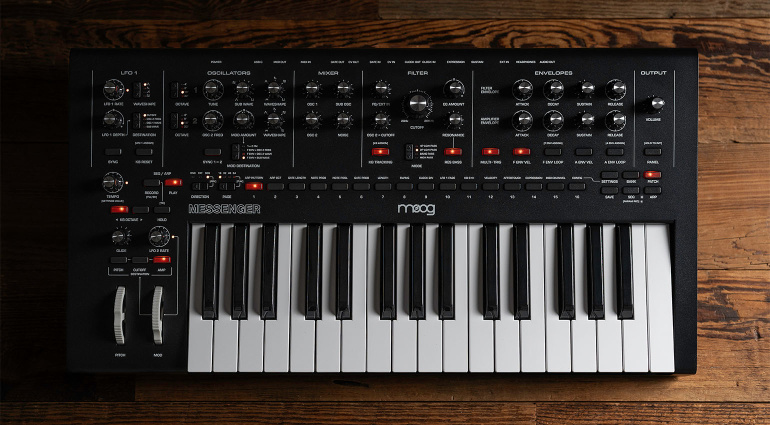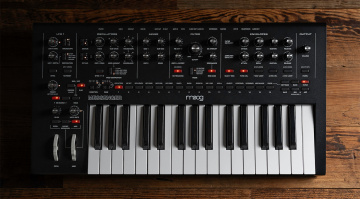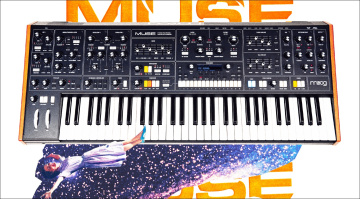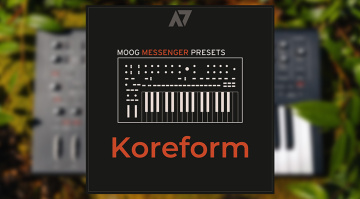Moog Messenger Review
Monophonic analog synthesizer
The Moog Messenger is supposed to mark the beginning of a new era for the legendary manufacturer and deliver authentic Moog sound at a significantly lower price than before. In our review, we take a closer look at the Messenger to find out if Moog is on the right track.
Moog Messenger Review
Moog Messenger: Quick Facts
- Monophonic analog synthesizer
- 32 keys with velocity and aftertouch
- 2 oscillators with variable waveform and wavefolder
- Sub oscillator
- Multimode ladder filter with resonance bass compensation
- 2 loopable ADSR envelopes
- 2 LFOs
- Step sequencer and arpeggiator
- 256 presets
Moog Messenger: The New Generation
I’ll admit that I had mixed feelings when Moog announced the Messenger at Superbooth 25. After all, it is the first Moog that was developed entirely under the ownership of inMusic. And the disturbing news about massive cutbacks and layoffs at Moog’s headquarters in Asheville are still ringing in our ears. For true fans, the acquisition of the former boutique manufacturer by inMusic will probably have a slight aftertaste for some time to come. Some people even went as far as saying that the Messenger couldn’t possibly be a real Moog.
Nevertheless, it wouldn’t be fair if I didn’t approach the synthesizer with an open mind. After all, nostalgia won’t stop the course of events. And if the “new” Moog has succeeded in building a synth that delivers a genuine Moog sound at a reasonably competitive price, that would be good news in my book. So let’s find out what message the Messenger delivers. What’s the new generation of Moog all about?

Moog Messenger: First Impression
Contrary to some early reports, I don’t think that the Messenger feels like “plastic” at all. Yes, the design is a bit more basic than what we were used to from Moog. It’s also quite possible that the materials were selected with costs in mind. But that doesn’t make the synth feel cheap. On the contrary: in comparison with instruments from some other major manufacturers, the hardware makes a reassuringly solid impression, in my opinion. With the exception of the side panels, the housing is made of metal and feels quite sturdy. The knobs don’t wobble and have a similar feel to my Sub 37, and the keyboard, wheels, and buttons are absolutely on par with other instruments in this price range. So yes, it does look and feel a bit less sophisticated than the Moogs of the good old days, but it’s still absolutely a well-built little synth.

Moog Messenger: Synthesis Architecture
Two oscillators, one filter, one VCA, two envelopes: this has been the basic formula for compact Moogs ever since the Prodigy. The previous Phatty series, which culminated in the Subsequent 37, also features this basic layout. However, the Messenger isn’t simply a rehash of old ideas, but has a few tricks up its sleeve that are uncharted territory for Moog. This promises a welcome (and maybe long overdue?) expansion of the classic Moog sound spectrum.
Let’s start with the two analog oscillators. In true Moog fashion, they offer continuously variable waveshapes from triangle to sawtooth to square. If you turn the knob further to the right, you’ll be controlling the pulse width. What’s new is that you can also turn the control further to the left beyond the triangle position. In this case, a wavefolder is activated, which folds the triangle wave with increasing intensity, resulting in interesting timbres previously unheard of from Moog. Of course, the waveshape can also be modulated.
In addition, the Messenger offers oscillator sync, FM (OSC 1->2), and a sub oscillator, which also features a variable waveshape and sounds an octave below oscillator 1. You can also add noise in the mixer and loop in an external audio signal. That’s plenty of source material for characterful sounds.
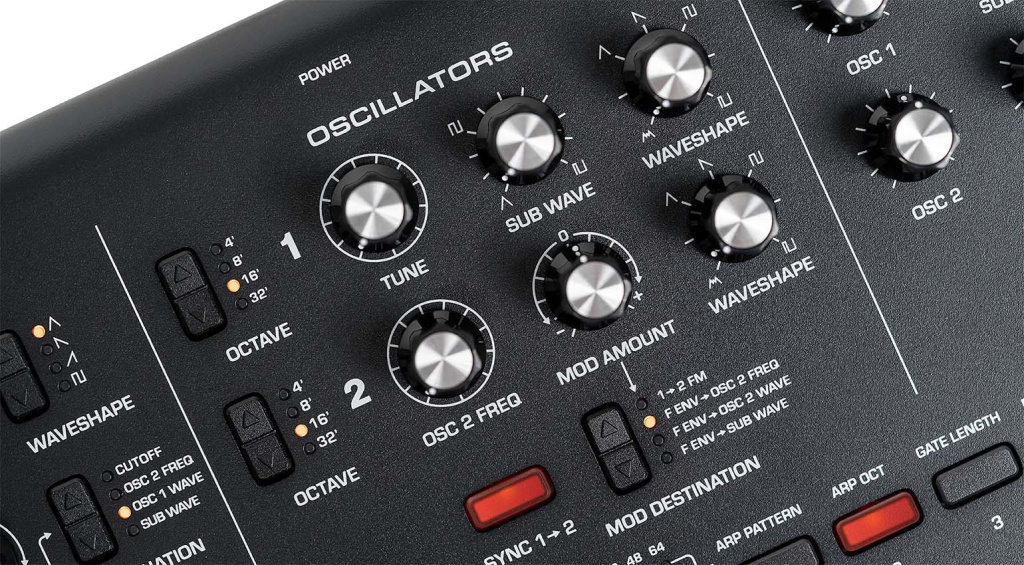
Moog has also broken with tradition in the filter section. Of course, the Messenger contains a variant of the famous ladder filter – otherwise it could hardly be called a real Moog. Unlike its predecessors, however, the filter isn’t limited to a 24 dB lowpass. Alternatively, you can choose from 12 dB lowpass, bandpass, and highpass modes, which significantly expands the sonic possibilities.
The RES BASS button is also new. When it is activated, it eliminates a typical but sometimes annoying behavior of the classic Moog filter. With classic Moog ladder filter designs, the bass tends to disappear when the resonance is turned way up. This new function compensates for this, allowing the low frequencies to come through at full force even in sounds with a lot of resonance. A very useful feature that fans of fat basses will appreciate!
The rest of the synthesis architecture is fairly straightforward and follows in the tradition of the Phatty series. The Messenger offers two loopable ADSR envelopes that can react to keyboard velocity. One of them is pre-wired to the VCA, the other to the filter. The filter envelope can also be used to control various parameters of oscillator 2, and you can assign it to one additional parameter of your choice via the Assign button.
Next up are two LFOs. One of them has all the bells and whistles and offers a choice of triangle, sawtooth, ramp, and square waves. Sync and keyboard reset are also available. LFO 1 can modulate the filter cutoff, oscillator 2 frequency, oscillator 1 waveshape, or sub waveshape. Like the filter envelope, you can also assign it to one other parameter of your choice.
LFO 2 is much more basic and is linked to the modulation wheel. This is a triangle LFO that affects the pitch, cutoff, and/or amp when the wheel is turned up.
What Does the Moog Messenger Sound Like?
Enough of the theory – what does the Moog Messenger sound like? A first tour through the 256 presets reveals a wide spectrum of familiar Moog timbres – and many refreshingly non-familiar ones. The Messenger can absolutely deliver the rich basses that are synonymous with the brand, and the new bass compensation feature really pays off. It also does a great job with piercing sync leads and bubbly arpeggios. In a nutshell, the Messenger covers the classic repertoire of monophonic Moog sounds quite convincingly.
However, I found the sounds that make use of the non-traditional features the most interesting. The wavefolder and the additional filter types are great extensions of the standard Moog architecture. In fact, I’m now a bit bummed out that my Sub 37 doesn’t have them! It’s great to see Moog experimenting in this direction.
Speaking of the Sub 37: I can’t deny that I do have the feeling that the Messenger sounds ever so slightly less “expensive”, for lack of a better word. However, I can’t quite put my finger on what causes this impression. So it may very well be purely subjective. Perhaps it is also due to the fact that I find the factory presets a bit uninspired. However, all things aside, the bottom line is: The Messenger is an excellent-sounding analog synth that fits today’s sonic aesthetics very well and can deliver a surprisingly wide spectrum of sounds. In my book, it absolutely deserves the name Moog.
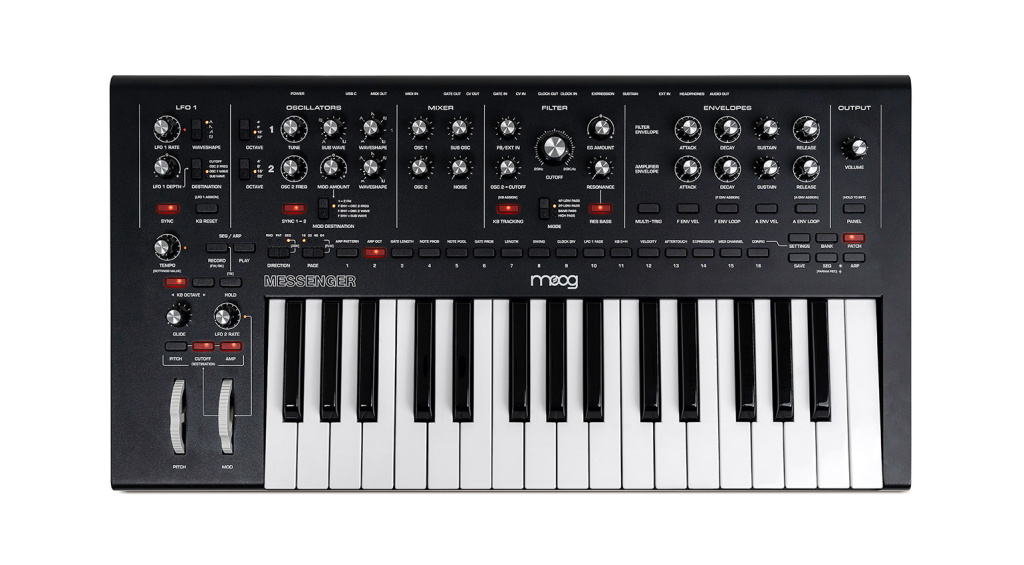
Sequencer
The Messenger’s built-in sequencer is quite capable and a big improvement over the previous Phatty series. With drastically expanded possibilities, it makes the synth play very well with other loop-based gear such as drum machines and grooveboxes.
The sequencer offers up to 64 steps per pattern; arbitrary lengths are also possible. Each patch lets you create and store one pattern. The gate length and swing are adjustable. Unlike the Sub / Subsequent 37, the Messenger’s sequencer also lets you record sound parameters per step, so you can use it as a modulation source. It’s important to note that it doesn’t allow for continuous recording of knob movements. But you can program parameter changes per step, similar to Elektron’s parameter locks, for example.

There are also a couple of interesting randomization options. Gate Prob lets you set the trigger probability per step. Note Prob, which can also be activated per step, randomly picks notes from a previously defined Note Pool. When combined, these features can result in totally unexpected patterns, which I found very inspiring.
I also really liked the Arpeggiator. It offers a much larger pattern selection than the usual Up/Down/Up+Down, and some interesting octave options. Another great feature is the ability to spontaneously program a rhythm using the step buttons while the arpeggiator is running. This quickly turns simple 16th note arpeggios into rhythmically interesting patterns – an inspiring hybrid of arpeggiator and sequencer.
Conclusion: Moog Messenger
As the first Moog synthesizer developed under the direction of inMusic, the Messenger is intended to carry the Moog brand into the future and offer a rich Moog sound at a more affordable price. And although I was a bit skeptical at first, I’m happy to report that it’s a success. The Messenger is a great little synth that not only delivers the entire palette of classic Moog sounds in convincing quality, but also offers a very welcome expansion of the sonic spectrum thanks to wavefolders and additional filter options. This means that it can produce many interesting and inspiring sounds that weren’t previously part of the Moog repertoire.
I also really liked the integrated sequencer and arpeggiator, which represents a big step forward compared to the Phatty series. The overall package is convincing, especially at this price. Considering its sound and features, it’s easy to forgive the Messenger for not being quite as stylish and elegant as the older Moogs.
Price and Availability
You can get the Moog Messenger from Thomann* for $799 / £722 / €829 (as of June 18, 2025).

Moog Messenger: Pros and Cons
Pros
- Classic Moog sound at a lower price
- Two analog oscillators with wavefolders
- Sub oscillator
- Multimode ladder filter with resonance bass compensation
- Versatile sequencer and arpeggiator
- Intuitive user interface
Cons
- Somewhat uninspired factory presets
More Information

*This post contains affiliate links and/or widgets. When you buy a product via our affiliate partner, we receive a small commission that helps support what we do. Don’t worry, you pay the same price. Thanks for your support!

 4,3 / 5,0 |
4,3 / 5,0 | 